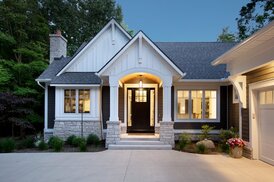Location: Washington D.C.
Contractor: Tom Stalheber, Stalheber Construction, Bethesda, Md.
Designer: Hans Kuhn, Chris DeHenzel, John Burke, Studio 27 Architecture, Washington, D.C.
This 104-year-old rowhouse on Capitol Hill had a compartmentalized interior. The owners needed better circulation and wanted an open space that felt like an art gallery. Architects John Burke, Hans Kuhn, and Chris DeHenzel of Studio 27 Architecture, in Washington, D.C., arrived at the idea of a light tunnel to admit light and bring an airy feel to the center of the house.
The homeowners were willing to sacrifice square footage on the second floor to create the light tunnel. Contractor Tom Stalheber removed a section of the upper-level floor joists to carve the void through the center of the house.
A tubular steel and glass bridge spans the space between the two upstairs rooms. “The door in the bedroom is on the same axis as the glass bridge and the front bay window. If you stand on the bridge, you have a nice view with the door on one side and the bay window on the other,” Kuhn says. The team had planned for a glass railing for the bridge, but a steel welded railing offered a more cost-effective solution.
The remodeled main floor of the house has the feel of a plaza or outdoor space. “What would normally be the most dark space is now the lightest,” Kuhn says. Full-expanse doors across the back of the house not only provide connection to the outdoors but, combined with the operable skylight, contribute to ventilation. “If you open the wall on the back, then open the skylight, you have that heat-stack effect,” Kuhn says.
Natural ventilation was important to the clients, who considered ecological impact when reviewing the design and specifying materials. Green products used in the project include tankless water heaters, low-E glass windows and doors, bio-based insulation, low-flow plumbing fixtures, and dual-flush toilets.
In addition to having the light tunnel admit natural light, the designers also added a small bump-out on the side wall that has narrow windows on the sides, glass underneath, and a built-in desk. “Light flows above and beneath the desk, but you don’t have visual contact with the neighbors,” Kuhn explains.
The contractor had to insert an I-beam over the length of the bump-out to support the wall/roof structure above. “There are columns embedded in the closet and on each end of the opening of the bump-out to catch the load from above. There is also a steel tube spanning the width of the unit on each side of the floor openings to support the loads from the bathrooms and the bridge,” Kuhn says.
The designers fit a lot into the house and cleverly used every inch of space, said the jury panel, and the execution of the work is outstanding. In addition, the judges admired the green aspects of the project.
On the long wall across from the bump-out, the kitchen cabinetry steps down into low cabinets under the open-tread staircase. These cabinets provide additional storage, and the homeowners can also use them as a buffet when they entertain.
The designers did not want the stair stringer to be seen, so they asked the contractor to insert a steel tube in the wall, to which the treads could be welded. “The treads float with [visually] no support, as they cantilever off the wall,” Kuhn says. “This adds a lot of lightness to the space.”
The bright orange box that separates the stairs and the living room contains a powder room. A similar orange box on the back deck stores outdoor furniture.
—Nina Patel, senior editor, REMODELING.










